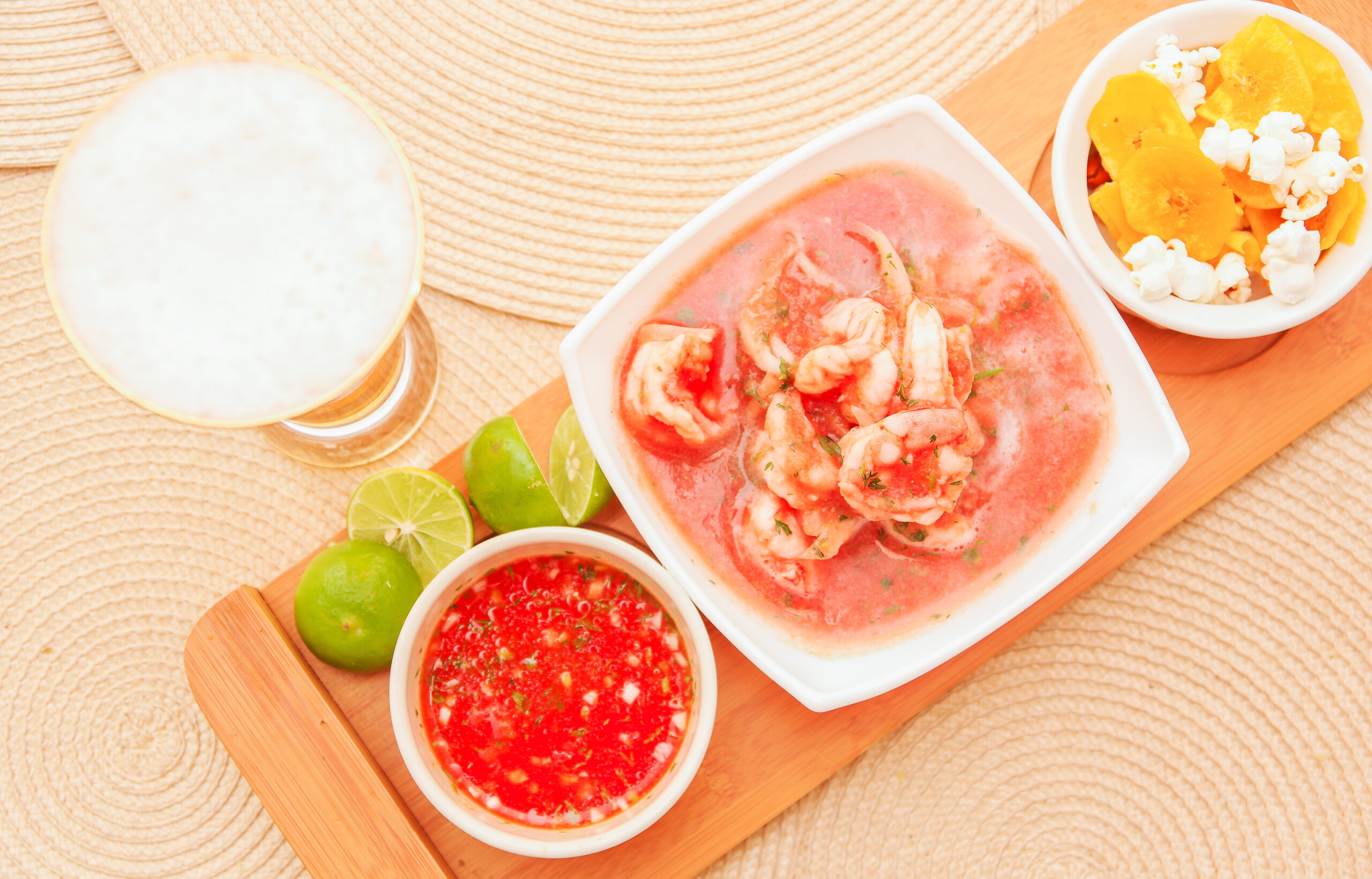The local cuisine is characterized by a combination of fresh marine ingredients and agricultural products grown on the islands. Typical dishes include ceviches, grilled fish, lobsters and a variety of tropical fruits. The culinary influence in the Galapagos comes primarily from continental Ecuadorian cuisine, with adaptations based on the resources available on the islands.
Sustainable fishing and local agriculture play a crucial role in gastronomy, promoting the conservation of the islands’ unique ecosystem. Local restaurants and markets offer visitors the opportunity to taste traditional dishes and learn about the sustainable culinary practices implemented in the archipelago. The gastronomy of the Galapagos Islands not only satisfies the palate, but also educates about the importance of conservation and the responsible use of natural resources.
Traditional dishes from the Galapagos Islands
Emblematic Dishes
One of the most emblematic dishes is the lobster ceviche, which consists of fresh lobster marinated in lemon, onion, tomato and cilantro. Another popular dish is fish encocado, which is fish cooked in a delicious coconut sauce and served with rice.
Seafood Rice and Other Options
Additionally, arroz sailor is a classic option that combines rice with fresh seafood, such as shrimp, squid, and octopus. The gastronomy of the Galapagos Islands also includes meat-based dishes, such as hornado, which is slow-roasted pork and served with mote (tender corn) and a fresh salad. These traditional dishes reflect the richness of local products and the culinary creativity of the region.
Delicious desserts
The gastronomy of the Galapagos Islands also includes a variety of delicious desserts. One of the most popular is dulce de higo, which consists of fresh figs cooked in panela (brown sugar) and spices. Another traditional dessert is queso de Hoja, which is fresh cheese wrapped in bijao leaves and steamed. These desserts reflect the indigenous influence on the cuisine of the Galapagos Islands and are a delicious way to end a traditional meal.
Culinary influences on the gastronomy of the Galapagos Islands
The gastronomy of the Galapagos Islands has been shaped by a variety of culinary influences over the centuries. Indigenous cuisine provided cooking techniques and the use of local ingredients such as fish, shellfish, tubers and fruits. The arrival of the Spanish introduced ingredients such as rice, wheat, pork and cattle, as well as preservation techniques such as salting and drying.
The African influence is reflected in dishes such as encebollado, a fish-based soup with onion and cilantro. Finally, Asian migration brought with it ingredients such as soy, ginger and garlic, as well as steaming and frying techniques. These culinary influences were combined to create a unique cuisine in the Galapagos Islands, which stands out for its diversity of flavors and textures.
The fusion of ingredients and culinary techniques has given rise to traditional dishes that are appreciated by both locals and visitors. The gastronomy of the Galapagos Islands is a reflection of the history and cultural diversity of the region.
Local ingredients and their importance in the cuisine of the Galapagos Islands
Local ingredients play a key role in Galapagos Islands cuisine. Sea products, such as fish, lobsters, shrimp and squid, are the basis of many traditional dishes. In addition, tropical fruits such as bananas, papayas, pineapples and passion fruit are used in desserts and refreshing drinks.
Root vegetables such as cassava and sweet potato are also key ingredients in local cuisine. The importance of local ingredients goes beyond the culinary aspect. Using local products promotes sustainability and supports local producers.
By using fresh and local ingredients, you reduce your ecological footprint and boost the local economy. In addition, local ingredients bring authentic and unique flavors to traditional dishes. In short, local ingredients are essential to preserve the authenticity and sustainability of the gastronomy of the Galapagos Islands.
Unique culinary experiences in the Galapagos Islands
The Galapagos Islands offer a variety of unique culinary experiences that go beyond simply trying traditional dishes. Visitors have the opportunity to participate in cooking classes where they can learn how to prepare ceviche, encocado or traditional desserts. Additionally, some restaurants offer themed dinners that highlight the culinary diversity of the region, combining traditional dishes with modern techniques.
Another unique culinary experience in the Galapagos Islands is visiting local markets, where you can find fresh ingredients and meet local producers. Markets are a great way to immerse yourself in local culture and discover new flavors and aromas. Finally, food festivals are not-to-be-missed events for those who want to explore the culinary diversity of the Galapagos Islands and enjoy live music, traditional dancing, and tastings.
Traditional recipes to try at home
For those who wish to experience the gastronomy of the Galapagos Islands from home, here are some traditional recipes to try:
1.Lobster ceviche: Cut the fresh lobster into small pieces and marinate it with lemon juice, chopped red onion, chopped tomato, chopped fresh cilantro, salt and pepper to taste. Serve with green plantain chips or toast.
2.Fish encocado: In a large pot, cook chopped onion and garlic in oil until golden. Add coconut milk, tomato paste, fresh fish cut into pieces, salt and pepper to taste. Cook over low heat until the fish is tender. Serve with white rice.
3.Fig candy: Boil fresh figs with panela (brown sugar), cloves and cinnamon until a thick syrup forms. Serve hot or cold with fresh cheese. These recipes will allow you to enjoy the authentic flavors of the Galapagos Islands from the comfort of your home and experience the culinary richness of this fascinating region.
